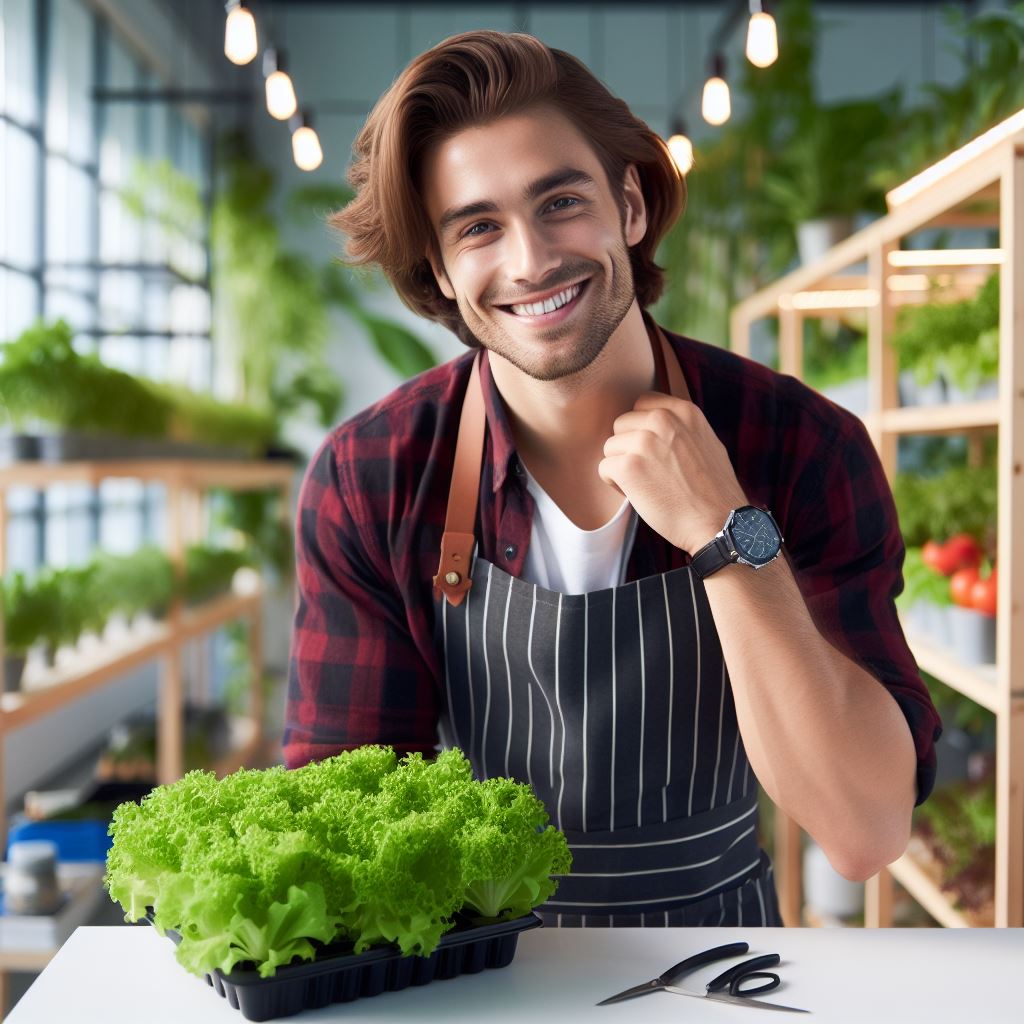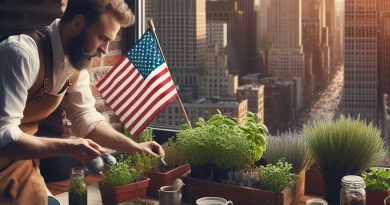Small Space, Big Yield: Hydroponic Tips
Last Updated on February 4, 2024
Introduction
Unlocking the secrets of hydroponics transforms cramped spaces into thriving gardens.
Sidestep soil limitations and embark on an adventure in high-yield, space-efficient cultivation.
In this blog post, discover innovative hydroponic strategies tailored for compact environments.
Uncover the power of nutrient-rich solutions, vertical gardening, and precision cultivation.
Brace yourself for a journey where every inch counts, yet yields bountiful harvests.
Get ready to elevate your gardening game, turning small spaces into flourishing oases.
Delve into our hydroponic tips – where limited room meets limitless potential.
Stay tuned for groundbreaking insights, cultivating abundance in even the tiniest corners.
Your journey to a verdant, space-maximizing garden begins here.
Let’s embark on this hydroponic odyssey together, proving that size is no match for the grandeur of nature within your grasp.
Benefits of Hydroponics for Small Spaces
Hydroponics is a suitable option for small spaces due to its numerous benefits.
It allows individuals to maximize limited areas and produce a high yield.
Additionally, hydroponics enables year-round cultivation without the need for soil.
Maximizing Limited Areas
Hydroponics is an excellent choice for small spaces because it allows individuals to make the most of their limited areas.
Unlike traditional gardening, which requires ample space for soil beds and plants, hydroponics utilizes vertical gardening techniques.
By growing plants vertically, individuals can save valuable floor space and still achieve a productive garden.
Producing a High Yield
One of the key advantages of hydroponics in small spaces is its ability to produce a high yield.
Since plants are grown in a controlled environment with a nutrient-rich solution, they grow faster and healthier compared to traditional methods.
The optimized conditions provided by hydroponics lead to increased plant growth and ultimately result in a higher yield.
Year-Round Cultivation
Another significant benefit of hydroponics for small spaces is the potential for year-round cultivation.
Unlike traditional gardening, which is heavily dependent on seasonal changes and weather conditions, hydroponics offers flexibility.
With the use of artificial lighting and climate control systems, individuals can grow plants irrespective of the outdoor climate.
This means fresh fruits, vegetables, and herbs can be cultivated all year long, even in regions where severe winters or limited sunlight may hinder traditional gardening.
No Soil Requirement
Hydroponics eliminates the need for soil, making it highly suitable for small spaces.
Instead of relying on soil, plants are grown in a nutrient-rich water solution or a soilless medium.
In addition to reducing the heavy load associated with soil, this also eliminates common issues such as soil-borne diseases, pests, and weeds.
Without soil, individuals can maintain a cleaner and more manageable garden in their limited space.
Efficient Use of Water and Nutrients
Hydroponics systems enable efficient use of water and nutrients, making them a sustainable choice for small spaces.
Unlike traditional gardening, which often leads to water wastage through evaporation and inefficient soil absorption, hydroponics recirculates and reuses water.
This both conserves water and ensures that plants receive an adequate supply of nutrients, promoting healthy growth and minimizing waste.
Reduced Maintenance and Labor
Hydroponics requires less maintenance and labor compared to traditional gardening methods.
Without the need for soil management, weeding, or tilling, individuals can focus on other aspects of their garden, such as monitoring nutrient levels and pH balance.
Additionally, hydroponics systems can be automated, reducing the need for constant monitoring and manual intervention.
This makes hydroponics an ideal option for those with limited time or physical capabilities.
In fact, hydroponics offers numerous benefits for small spaces.
It allows individuals to maximize limited areas, produce a high yield, and cultivate plants year-round without the need for soil.
With its efficiency in water and nutrient usage, reduced maintenance requirements, and the ability to grow plants vertically, hydroponics is an excellent choice for those looking to maximize their small spaces and enjoy a productive garden.
Choosing the Right Hydroponic System
When it comes to growing plants in small spaces, hydroponic systems offer an excellent solution.
These systems allow you to grow plants without the need for soil, maximizing space utilization and ensuring a big yield of healthy crops.
However, choosing the right hydroponic system for your small space can be a daunting task.
With a wide range of options available, it’s important to carefully consider the pros and cons of each system and assess your space, budget, and maintenance requirements before making a decision.
One of the popular hydroponic systems suitable for small spaces is the Nutrient Film Technique (NFT).
In this system, a thin film of nutrient-rich solution continuously flows over the roots of the plants, providing them with essential nutrients.
NFT systems are known for their simplicity and efficiency, making them a great choice for beginners.
However, they require a constant supply of electricity to maintain the nutrient flow, which can be a drawback for some growers.
Another option to consider is the Deep Water Culture (DWC) system.
This system involves suspending plants with their roots submerged in a nutrient solution.
The roots absorb oxygen from an air pump, ensuring proper aeration.
DWC systems are easy to set up and maintain, making them suitable for small spaces.
However, they may require additional equipment such as air pumps, and it’s essential to maintain proper oxygen levels to prevent root rot.
Aeroponics is another hydroponic system to explore for small spaces.
This system involves suspending plants in the air and misting the roots with a nutrient-rich solution.
Aeroponic systems provide excellent oxygenation to the roots, ensuring fast growth and higher yields.
They also conserve water compared to other systems.
However, aeroponic systems can be complex to set up and maintain, requiring a high level of expertise and attention to detail.
Importance of considering space, budget, and maintenance requirements before choosing a system
When choosing the right hydroponic system for your small space, it’s crucial to assess your available space, budget, and maintenance capabilities.
Some systems, like NFT and DWC, require minimal space and are relatively affordable.
However, systems like aeroponics may require more space due to the misting apparatus and can be more expensive to set up.
Additionally, consider the time and effort you are willing to invest in maintenance.
Some systems require meticulous monitoring and adjustment of nutrient levels, while others may be more hands-off.
In short, choosing the right hydroponic system for small spaces is a crucial decision that can significantly impact your plant’s growth and yield.
Evaluate the pros and cons of systems such as NFT, DWC, and aeroponics, taking into account your space, budget, and maintenance requirements.
Remember, each system has its advantages and drawbacks, so it’s essential to choose one that aligns with your specific needs and goals.
With careful consideration, you can enjoy the benefits of hydroponic gardening even in the smallest of spaces.
Read: Small-Scale Farming: From Seed to Table
Selecting the Ideal Plants
Hydroponic gardening offers a unique opportunity to grow a wide variety of plants in small spaces.
With the right selection of plants, you can achieve big yields and enjoy the benefits of fresh, homegrown produce.
Here is a list of plants that thrive in small hydroponic setups, along with their characteristics in terms of size, growth rate, and nutrient requirements:
Lettuce
- Size: Lettuce plants are compact and don’t require much space to grow.
- Growth rate: They have a relatively fast growth rate, ready for harvest within a few weeks.
- Nutrient requirements: Lettuce plants have moderate nutrient requirements and grow well in most hydroponic nutrient solutions.
Herbs
- Size: Most herbs are small and can fit well in small hydroponic setups, even on windowsills.
- Growth rate: Herbs generally have a moderate growth rate, allowing for consistent harvests.
- Nutrient requirements: Herbs usually have low to moderate nutrient requirements, making them suitable for hydroponic systems.
Cherry Tomatoes
- Size: Cherry tomato plants can be grown in small pots or containers, taking up minimal space.
- Growth rate: They have a moderate growth rate, with fruits reaching maturity in about 60-80 days.
- Nutrient requirements: Cherry tomatoes require a nutrient-rich growing solution, but the results are worth it due to their delicious fruits.
Strawberries
- Size: Strawberry plants are small and can be grown in vertical systems, maximizing space utilization.
- Growth rate: They have a moderate growth rate, with a continuous harvest throughout the growing season.
- Nutrient requirements: Strawberry plants require a slightly acidic nutrient solution and thrive in well-oxygenated hydroponic setups.
Peppers
- Size: Depending on the variety, pepper plants can be compact and suitable for small hydroponic setups.
- Growth rate: They have a slow to moderate growth rate, with peppers maturing within 60-100 days.
- Nutrient requirements: Peppers have moderate nutrient requirements and can adapt well to various hydroponic nutrient solutions.
Radishes
- Size: Radishes are small root vegetables that can be grown in hydroponic systems with shallow water culture.
- Growth rate: They have a fast growth rate, with radishes ready for harvest within 3-4 weeks.
- Nutrient requirements: Radishes prefer a balanced nutrient solution without excess nitrogen for optimal root development.
Cucumbers
- Size: Miniature cucumber varieties, such as bush cucumbers, are suitable for small hydroponic setups.
- Growth rate: They have a moderate growth rate, with cucumbers ready for harvest within 50-70 days.
- Nutrient requirements: Cucumbers need a nutrient-rich solution, particularly during flowering and fruiting stages.
Beginner-friendly choices with high yields include lettuce, herbs, and cherry tomatoes.
These plants are relatively easy to grow, have moderate nutrient requirements, and provide a bountiful harvest.
They are perfect for those new to hydroponic gardening or limited by space constraints.
Experiment with different plant varieties and enjoy the satisfaction of growing your own fresh produce with hydroponics.
Read: Window Box Farming: Herbs and Flowers
Maximizing Space Efficiency
In small-scale hydroponic gardening, space efficiency is crucial for maximizing the yield.
With limited space, it’s essential to utilize every inch efficiently to grow a bountiful harvest.
Here are some tips and techniques to make the most of your available space:
- Employ Vertical Gardening: Grow plants upward using trellises, stakes, or cages, maximizing space for vining plants.
- Utilize Trellises: Train plants to climb trellises for organized, space-saving gardens, improving air circulation and sunlight exposure.
- Adopt Hanging Systems: Suspend baskets or containers to utilize vertical space for compact herbs, strawberries, and small vegetables.
- Ensure Proper Spacing: Optimize air circulation, reduce disease risks, and access nutrients by adhering to recommended plant spacing guidelines.
- Plan Strategic Plant Arrangements: Maximize growth and yield through careful layout planning, incorporating intercropping for space efficiency and pest deterrence.
- Practice Companion Planting: Grow compatible plant species together to create a synergistic ecosystem, saving space and enhancing overall yield.
- Embrace Succession Planting: Ensure a continuous harvest by continuously sowing seeds or transplanting seedlings throughout the growing season.
- Choose Efficient Containers: Opt for compact or specialized hydroponic containers, considering stackable or tiered systems for vertical space efficiency.
- Harness Microgreens: Cultivate young, nutrient-rich microgreens with minimal space requirements for a quick and flavorful addition to dishes.
- Explore Creative Solutions: Repurpose items like hanging shoe organizers, old furniture, or experiment with different hydroponic techniques for maximum space efficiency.
In essence, hydroponic gardening in small spaces requires careful planning and strategic measures to ensure optimal yield.
By implementing techniques like vertical gardening, trellising, and utilizing hanging systems, you can make the most of your available space.
Remember to consider proper spacing, plant arrangements, and container selection to optimize space utilization.
With a little creativity and attention to detail, you can transform a small space into a thriving hydroponic garden.
Read: Urban Green: Edible Plants in Pots

Nutrient Considerations
In hydroponic systems, nutrient solutions play a crucial role in providing plants with the essential elements necessary for growth.
Maintaining the right balance of nutrients is essential for achieving maximum yield.
Importance of Nutrient Solutions
Nutrient solutions act as a substitute for soil in hydroponic setups, providing plants with a readily available source of essential elements.
Unlike traditional soil-based growing methods, hydroponics allows for precise control over nutrient uptake.
By maintaining appropriate nutrient levels, hydroponic systems ensure optimal plant growth and development, leading to higher yields and healthier plants.
Essential Elements for Plant Growth
Plants require a range of essential elements to thrive.
These include macronutrients like nitrogen, phosphorus, and potassium, as well as micronutrients such as iron, manganese, and copper.
Nitrogen (N) is vital for leaf and stem growth, while phosphorus (P) promotes root development and flower/fruit production.
Potassium (K) is responsible for overall plant health, disease resistance, and vigorous growth.
Micronutrients, although needed in smaller quantities, are equally important.
They support various metabolic functions such as enzyme activation and chlorophyll production.
Maintaining the Right Balance
When preparing nutrient solutions, it is crucial to maintain the right balance of essential elements to support optimal plant growth.
Imbalances can lead to nutrient deficiencies or toxicities, negatively impacting yields.
Guidance on Nutrient Solutions for Small-Scale Setups
- Choose a reputable hydroponic nutrient brand: Look for trusted brands that provide a complete range of essential elements in their formulations.
- Follow the manufacturer’s instructions: Different nutrient solutions are formulated for various growth stages. Follow the recommended dosage and adjust as needed.
- Monitor pH levels: pH affects nutrient availability to plants. Maintain a pH level between 5.5 and 6.5 for most crops, adjusting as necessary.
- Monitor electrical conductivity (EC): EC measures the concentration of nutrients in the solution. Ensure it stays within the recommended range for your plant variety.
- Check for nutrient deficiencies or toxicities: Learn to identify common symptoms and signs of nutrient imbalances to take corrective action promptly.
- Consider adding supplements: Some plants may require additional supplements to thrive. Research specific plant requirements for optimal growth.
- Periodically flush and replace nutrient solutions: Over time, nutrient solutions can become imbalanced or depleted. Flush the system and replace with fresh solution regularly.
- Prevent contamination: Keep nutrient solutions clean and sterilize equipment regularly to avoid the growth of harmful bacteria or pathogens.
- Automate nutrient delivery: Consider using automated systems that regulate nutrient delivery based on plant needs, ensuring a consistent and balanced supply.
Nutrient solutions play a critical role in hydroponic systems, providing plants with the essential elements necessary for growth.
Maintaining the right balance is key to achieving maximum yield and overall plant health.
By following proper guidance and monitoring nutrient levels, small-scale hydroponic setups can produce bountiful harvests.
Read: Pollinators in the City: Urban Beekeeping
Lighting and Environmental Factors
Proper lighting is crucial for indoor hydroponics as it directly affects plant growth and yield.
Let’s explore the importance of lighting and discuss various options available:
Importance of Proper Lighting
Lighting plays a significant role in photosynthesis, the process by which plants convert light energy into chemical energy to fuel their growth.
Without adequate light, plants may struggle to grow and develop.
Moreover, lighting helps regulate the flowering and fruiting stages, which impact the overall yield.
Insufficient light can result in low-quality produce or even plant death.
Available Lighting Options
When it comes to indoor hydroponics, there are several lighting options to consider:
Fluorescent Lights
Fluorescent lights are popular among beginners due to their affordability and availability.
They emit a full spectrum of light, making them suitable for most plant growth stages.
Although fluorescent lights lack intensity compared to other options, they have low heat output and energy consumption, making them ideal for small-scale setups.
LED Lights
LED lights have gained popularity for their efficiency, durability, and versatility.
They provide high-intensity light tailored to specific plant requirements, promoting faster growth and increased yield.
LED lights also produce less heat, allowing them to be placed closer to plants without risking damage.
They have a longer lifespan and consume less energy, resulting in cost savings in the long run.
High-Pressure Sodium (HPS) Lights
HPS lights are favored for their ability to produce strong, consistent light output.
They emit red and orange spectrums that stimulate flowering and fruiting, making them ideal for the later stages of plant growth.
However, HPS lights have higher heat output and energy consumption compared to fluorescent and LED lights.
Proper ventilation and cooling systems are necessary to maintain optimal temperature and prevent plant stress.
Environmental Factors for Optimal Growth
In addition to lighting, several environmental factors are crucial for optimal plant growth in hydroponics:
Temperature
The temperature range should be carefully controlled to ensure the well-being of plants.
Most plants thrive in temperatures between 70°F and 80°F (21°C and 27°C).
Avoid extreme temperature fluctuations, as they can stress the plants.
Humidity
Humidity levels influence transpiration, the process through which plants absorb moisture and nutrients from the growing medium.
Different plants have varying humidity preferences, but generally, the ideal range is around 50-70%.
Ensure proper airflow and ventilation to prevent excessive humidity, which can lead to fungal diseases.
Use fans or dehumidifiers to maintain optimal humidity levels in the growing area.
Ventilation
Good airflow is essential for healthy plants.
Proper ventilation helps maintain consistent temperature and humidity levels, prevents the buildup of pests or pathogens, and ensures an adequate supply of carbon dioxide for photosynthesis.
Installing exhaust fans, intake fans, or duct systems can help maintain proper air circulation.
Regularly check for any blockages or obstructions in the ventilation system to ensure optimal performance.
Optimizing lighting and environmental factors is crucial for maximizing the productivity and quality of your indoor hydroponic garden.
Consider the available lighting options and carefully monitor temperature, humidity, and ventilation for successful plant growth.
Remember, each plant species has specific requirements, so it’s important to research and tailor the environment accordingly.
With proper lighting and ideal environmental conditions, you’ll be well on your way to a bountiful hydroponic harvest!
Pest and Disease Management
Advantages of Hydroponics in Pest and Disease Management
- Reduced risk of pests and diseases: One major advantage of hydroponics is the controlled environment that eliminates the risk of soil-borne pests and diseases.
- Prevention of pest infestations: With hydroponics, you have better control over the growing conditions, allowing you to prevent pest infestations before they occur.
- Faster pest detection: In hydroponic systems, pests are easier to spot due to the absence of soil, allowing you to detect and address pest issues promptly.
Tips for Preventing and Identifying Common Hydroponic Pests
- Maintain a clean environment: Start by keeping your hydroponic system clean, including all equipment, containers, and growing surfaces, to discourage pests from entering.
- Regularly monitor plants: Carefully inspect your plants regularly for any signs of pests, such as yellowing leaves, holes, or webbing.
- Use sticky traps: Place sticky traps near your plants to catch and monitor flying pests like whiteflies and fungus gnats.
- Introduce beneficial insects: Some beneficial insects like ladybugs, lacewings, or predatory mites can help control common pests in hydroponics systems.
- Implement proper sanitation practices: Remove any dead or decaying plants immediately to prevent pests from being attracted to your hydroponic setup.
- Quarantine new plants: Before introducing new plants to your hydroponic system, isolate them for a few days to ensure they are free of pests.
Suggesting Organic Alternatives for Pest Control
- Neem oil: Neem oil is an organic pesticide that can help control aphids, mites, and other common pests. Dilute it with water and spray it onto affected plants.
- Insecticidal soaps: These soaps are made from natural ingredients and are effective against soft-bodied pests like aphids, scale insects, and spider mites.
- Diatomaceous earth: Sprinkle food-grade diatomaceous earth around your hydroponic system to control crawling insects like ants, cockroaches, and slugs.
Methods for Early Disease Detection
- Regular inspection: Look for any signs of discoloration, spots, wilting, or abnormal growth on your plants, which can be indicators of disease.
- Isolate infected plants: If you notice disease symptoms on a plant, remove it from your hydroponic system immediately to prevent the spread of infection.
- Sterilize equipment: Clean and sterilize all equipment and containers between crop cycles to prevent the buildup and spread of pathogens.
- Maintain proper pH and nutrient levels: Ensuring optimal pH and nutrient levels in your hydroponic system will help prevent nutritional imbalances that can weaken plants and make them more susceptible to diseases.
In review, hydroponics provides numerous advantages for pest and disease management, including reduced risk of infestations, faster detection of pests, and controlled growing conditions.
By following preventive measures, using organic alternatives for pest control, and implementing early disease detection methods, you can maximize the yield and health of your hydroponic plants.
Harvesting and Maintenance Tips
Harvesting Hydroponic Crops
- Harvest your hydroponic crops when they have reached their maximum maturity and desired size.
- Use sharp, sterile tools to avoid introducing pathogens or damaging the plants during harvesting.
- Cut the stems 1-2 inches above the base to promote new growth and prevent any rotting at the base.
- When harvesting leafy greens, remove the outer leaves first to allow the inner leaves to continue growing.
- For fruiting crops, like tomatoes or cucumbers, wait until the fruits reach their full color and size.
Importance of Regular Maintenance
- Regular maintenance is crucial for ensuring the health and productivity of your hydroponic system.
- Monitor the pH levels of your nutrient solution daily using a pH meter to maintain optimal nutrient uptake.
- Adjust the pH levels by adding pH up or down solutions as necessary to keep it within the desired range.
- Regularly test the nutrient solution’s electrical conductivity (EC) to ensure proper nutrient concentration.
- Replace the nutrient solution every two to three weeks to prevent nutrient deficiencies and excess accumulation.
Pruning, Cleaning, and Algal Growth Prevention
- Prune your hydroponic plants regularly to remove dead or damaged leaves and improve air circulation.
- Remember to use clean, sterile tools when pruning to prevent the spread of diseases.
- Clean the hydroponic system components, such as grow trays and pumps, regularly to prevent clogs and algae buildup.
- Wipe down the surfaces with a mild bleach solution to kill any pathogens and algae.
- Avoid excessive light exposure by covering the grow trays to prevent algal growth in your hydroponic system.
Maintaining a healthy hydroponic system ensures maximum yield and reduces the risk of plant diseases.
Regular maintenance tasks, such as pH monitoring, nutrient solution changes, and pruning, are crucial.
By adhering to best practices, you can optimize your hydroponic system’s performance and crop quality.
Remember to always prioritize cleanliness and hygiene in your hydroponic setup to prevent contamination.
Following these harvesting and maintenance tips will help you achieve a flourishing hydroponic garden with abundant yields.
Conclusion
Hydroponics is a great option for those who have limited space but still want to grow their own fresh produce.
Through this blog post, we have discussed various tips to maximize the yield in small spaces using hydroponic systems.
By selecting the right system, ensuring proper lighting and ventilation, and maintaining nutrient levels, you can achieve impressive results in your hydroponic setup.
Don’t be discouraged by the size of your space; instead, see it as an opportunity to explore new ways of gardening.
With hydroponics, you can grow an abundant harvest right in your own home.
If you’re interested in starting your own small space hydroponic setup, we encourage you to take the leap.
The benefits of growing your own produce are numerous, from saving money to having healthier, pesticide-free crops.
We would love to hear about your experiences with hydroponics or answer any questions you may have.
Therefore, we invite you to share your thoughts, tips, and challenges in the comments section below.
Remember, even in a small space, with the right knowledge and techniques, hydroponics can yield remarkable results.
So don’t hesitate and start growing your own fresh and nutritious vegetables and herbs today!


